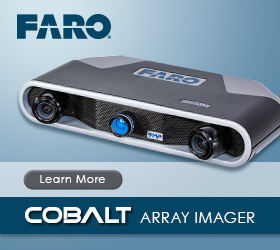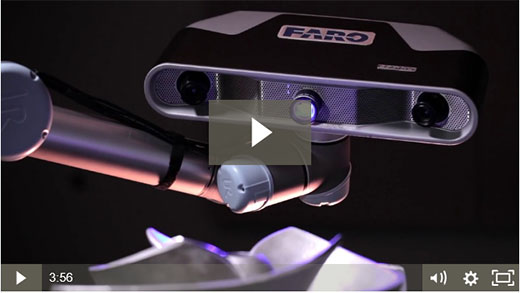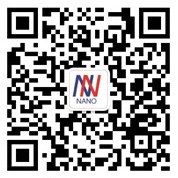Streamlining Workflow With Automated Inspection
Although part inspection is only a portion of the total workflow in your manufacturing operation, reducing that percentage of the workload has the potential to deliver significant returns on investment (ROI), in particular, when automation is introduced into the inspection process.
Streamlining Workflow With Automated Inspection
Choosing measurement solutions that match needs is key
PUBLISHED: TUESDAY, JULY 18, 2017 - 12:01
Sponsored Content
Although part inspection is only a portion of the total workflow in your manufacturing operation, reducing that percentage of the workload has the potential to deliver significant returns on investment (ROI), in particular, when automation is introduced into the inspection process.
The key to seeing ROI of company capital is choosing the inspection solutions that address the bottlenecks, blind spots, and potential inconsistencies within your own particular workflow.
Mechanical means in a digital world
“Coordinate measuring machines [CMMs] and mechanical inspection are still used by some companies, or divisions within a company,” says Jeff Moore, president of The Layout Source(TLS). “Because so many techs who are experienced in mechanical inspection are retiring and leaving the industry, that is still one of the prongs of my business. When there is no CAD model available for an obsolete part, there’s only a blueprint to work from, so mechanical inspection is the only option in that case.”
Other facets to note when considering inspection options are dealing with a paradigm shift from legacy to new technology, and cost of new systems. Savvy organizations will calculate time savings of digital inspection vs. mechanical, investigate digital solution investments, and figure time to ROI. In most cases, the cost savings and potential for increased throughput far outweigh the challenges of transitioning to a digital solution.
Mechanical shortcomings and digital solutions
Although historical methods for performing dimensional inspection still have value in certain situations, compared to 3D scanning, mechanical inspection systems using height gauges, surface plates, and rotary tables are slow and subject to human error or deviation, depending on who is doing the inspection.
“CMMs have a high cost-to-output ratio when inspecting one point at a time, compared to thousands per second as in 3D imaging or scanning,” explains Moore. “Tabulated CMM reports also add cost to the first article inspection [FAI] review. CMMs are suited to prismatic geometry but do not perform well when attempting to measure patternmakers draft or rough-cast surfaces.”
The Layout Source (TLS) is a quality inspection company that specializes in FAI on complex aerospace castings. The company’s use of an automated digital inspection system for the highly demanding requirements of the aerospace industry also allows repetitive FAIs be completed in a fraction of the time and cost compared to any other method. Further, production inspection can be completed in minutes with full digital documentation of the actual results.
Although TLS primarily serves the aluminum and magnesium alloy casting industry, its focus stands as an object lesson for any manufacturing operation that includes machining.
“When you produce a casting and have to machine it, you are relying on the fact that the casting is oversized and then machined in critical areas to get the final part,” says Moore. “The part of the process that we are focused on is the targeting aspect of it. Targeting is basically defining key datums or touch-points on the casting that an operator uses to set up the casting in the machining center. If an operator unintentionally machines at a slight offset or angle, you might machine into a critical area; that part could end up as costly scrap.”
In other words, because targeting manually is not as accurate as it could be with 3D imaging or scanning, there’s a certain amount of waste built into the manufacturing process and accounted for. 3D imaging technology, such as the FARO Cobalt Array Imager, improves the efficiency of a process, which will produce a cost savings because of reduced scrap.
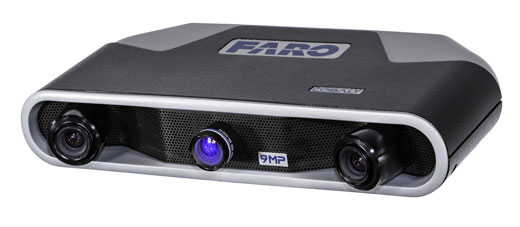
The FARO Cobalt Array Imager is a metrology-grade noncontact scanner that utilizes blue light technology to capture millions of high-resolution 3D coordinate measurements in seconds.
Easily deployed in manual or fully automated workflows, Cobalt delivers fast and consistent measurements for dimensional inspection and reverse engineering applications on parts, assemblies, and tooling.
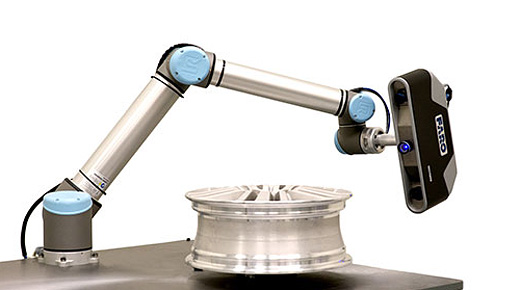
Cobalt is ideally suited for automated metrology applications within many industries, such as automotive, aerospace, metalworking, and other sectors utilizing automation.
“One of the useful features of the Cobalt is that it allows us to change the exposure settings,” says Rohit Khanna, president of 3D InfoTech (3DI). “Sometimes you have a very shiny part, and sometimes you have more of a matte finish. You can handle a wide variety of part finishes with the Cobalt.”
3D imaging and scanning are replacing many of the mechanical aspects of measurement, making them much easier and less prone to inspector error.
Click here to schedule a FREE 15-minute personalized live web demo of the Cobalt Array Imager, or call FARO at 800.736.0234 |
Automated solutions for the production environment
The next level of inspection solutions is integrating automation. Automated metrology systems provide several benefits for medium- to high-volume operations—especially tier 1–3 suppliers.
First, several aerospace OEMs are seeking to implement production part approval process or PPAP (100-percent inspection), which has already been adopted in the automotive industry. To run 100-percent inspection, automation is critical to ensuring consistent, repeatable inspections and ultimately staying profitable. Digital inspection systems are often not equipped for that level of automation, resulting in each part having to be independently inspected, thus reducing consistency or causing the process to be performed on a programmable CMM.
Second, 100-percent inspection produces copious amounts of data that can be used to optimize tolerances for production, and aid in better engineering.
“The idea is to enable production inspection for every part made,” says Moore. “That’s a goal shared by myself and many others within the aerospace, automotive, and other manufacturing industries. The data is important. Of course, we don’t want to end up rejecting every single part, but we want to learn from the data. Data properly analyzed becomes actionable information. That information allows engineers to go in, analyze nonconformities, and either open the tolerances or change the way things get inspected, or whatever it takes to find a solution to the data.”
Simply put, the benefits of an automated solution in high-volume inspection include time savings, reduced operator fatigue, and increased repeatability in inspection.
Tailored solutions
3D Infotech (3DI) is a metrology 3D systems integrator, specializing in automated metrology solutions with its Streamline software, which synchronizes all the processes in automated metrology.
“Our UMA [Universal Metrology Automation] solution includes a robotic arm with a scanner, rotary table, our software called Streamline,” says Khanna. “When we designed this system, we went through an evaluation phase where we looked at a variety of scanners, as well as robotic arms, before we proposed the final package, which in terms of hardware, incorporated the FARO solution with the Universal Robot. With this setup, the operator places a part on the rotary fixture, hits the “play” button in Streamline, waits for it all to be done, and the measurement data is automatically saved into their CAD program, where it can be reviewed and used to make real-time adjustments or for additional work offline, if necessary.”
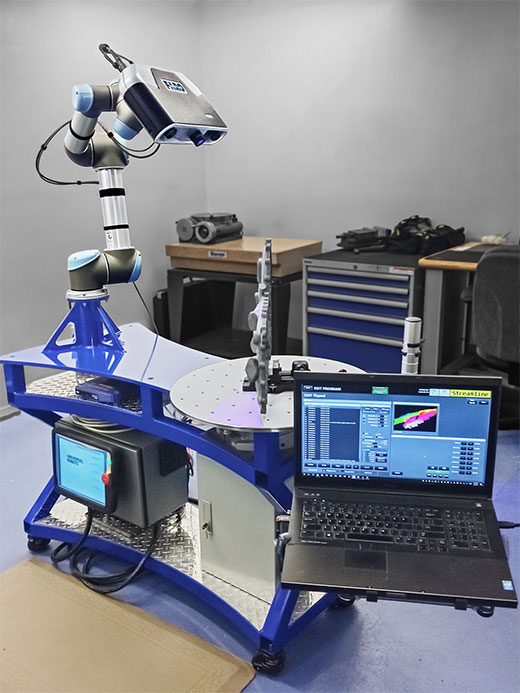
For 3DI, it’s all about tailoring the solution to the challenge.
“For us, a solutions provider, we have to ask all the questions and understand how it’s going to be used,” explains Khanna. “We find out what the accuracy requirements are, how it’s going to be moved if it’s a portable system, and then propose the best and most cost-effective solution that will fit those requirements.
“The engine behind UMA is the Streamline software. As of today, we can connect with three different robots. Streamline uses a touch-screen interface with a visual cue to select a job, and basically a DVD-style play-and-stop button to run the job. It does the inspection in Polyworks, then delivers the report—all in one nice workflow.

“The scalability is a very important component for multiple reasons. If a customer wants to change to a different robot, it’s a plug-and-play swap. If he wants to connect to a back-end data base, it’s a plug-and play change. Streamline has those features built in. If it’s a system that’s going to be in a factory where there’s another robot or maybe a conveyor belt serving the parts to the inspection cell, that’s a plug-and-play; Streamline can talk to PLCs right out of the box.”
FARO products find their way into many of 3DI’s solutions.
“3D Infotech has been around for more than twelve years,” says Khanna. “Since inception, we have worked with pretty much all the products made by FARO. The company has always been a great support for us. Any time there’s any question or issue, FARO is always proactive in supporting us. We trust and rely on FARO’s products and technology, and their people really stand out.”
Conclusions
Inspection time and effort is greatly reduced through automation. Once you program the robot and the Cobalt to inspect the first part, the remaining parts can be inspected automatically with no process or result variances from one operator to another. A part that used to take eight weeks for a mechanical FAI can be completed in five weeks for a digital FAI (scan program and inspect is a few days), 2.5 weeks for recurring FAIs, and minutes for production inspection.
In the end, each organization must do its own due diligence to discover the inspection solution best suited to its own needs. Fortunately, companies like The Layout Source, 3D Infotech, and FARO have decades of combined experience and are more than willing to share their insights.

